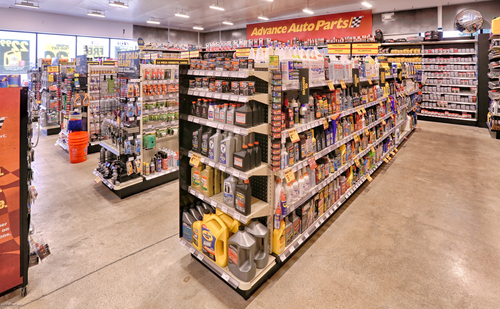BUSINESS
Earning Her Business
Optimizing Your Brand Experience to Attract and Retain Female Customers
By Douglas McColloch

emotion and creativity—is twice as large as mens’ limbic brains,
according to brand experience specialist Katie Mares. Knowing how
to distinguish between mens’ and womens’ cognitive perceptions
within a retail setting can make a big difference in a company’s
bottom line. Photo credit: Shutterstock.com
While the specialty-equipment aftermarket has traditionally been a male-dominated profession, the demographic landscape has changed markedly in recent years, and nowhere more so than in the consumer sphere, where women make up a sizable plurality of purchasers. A 2014 study by United Parcel Service found that women account for some 40% of all online auto-parts sales, and a 2018 SEMA “Young Accessorizers Report” found that nearly one-third of accessorizers under age 25 are female, so women consumers clearly comprise a healthy market segment that specialty-equipment companies would be wise not to overlook.
But marketing to male and female consumers is not necessarily a one-size-fits-all proposition. There are profound differences in how men and women operate in the retail space. Understanding the impact women have on purchasing decisions and how the physiological differences between men and women can drive those decisions was the subject of a recent SEMA360 Education webinar, “Earning Her Business.”
Presented by brand experience expert and public speaker Katie Mares, the session explored the subject in greater detail, with the aim of helping companies optimize their customers’ brand experiences to positively affect customer satisfaction metrics, increase retention rates and referrals, and improve a company’s bottom line. What follows is a summation of the webinar.
Women influence more than 80% of all purchases in the home, accounting for some $30 trillion in worldwide spending.
“Not only does she influence the purchases of her girlfriends but also the purchases of her spouse, her significant other, her sister, her brother, her mother, her father and her children,” Mares said. “A problem arises when one considers that women have been underserved and sometimes unserved altogether in the automotive retail space. We aren’t treated like an actual consumer base that is worthy of an experience that we like, that we want to interact with.”

majority of new-vehicle sales, so the successful retailer or service
shop will understand how to tailor its marketing and sales strategies
to meet the particular expectations of its female customer base.
Photo credit: Shutterstock.com
The answer? Mares advised retailers to “move away from the transactional experience that you’re probably currently giving to your consumers, especially to your female consumers, and go from transaction to interaction.”
Due to the fact that the automotive space remains dominated overwhelmingly by men, particularly at the executive/decision-maker level, “a female’s customer experience is still primarily designed by men, created by men, and delivered by men for men, but women are the ones who are influencing most of the purchases. When you create a [retail] experience she can’t live without, you’re winning not only her heart, her mind and her wallet, but you are also earning the hearts and minds and wallets of everyone who surrounds her. Women are the original social media.”
Mares also reminded that women account for more than 60% of automotive service requests and more than 60% of new-vehicle sales in North America, “so she has the right to demand an experience that speaks to her needs.”
How to optimize your brand experience to attract and retain female customers? Mares offered a few tips.
Understanding your female consumers means understanding their life stage, not simply their age.
“You want to break down your customer segmentation, and not just by age, because age doesn’t really matter anymore,” Mares continued. “You want to take a look at her position in life—the stage that she’s in. That means that you want to ask: ‘Is she single? Is she married? Does she have children? Is she an empty-nester?’ All of those things have and hold way more merit than whether she is 30 or 45.”
Women are getting married later in life, Mares noted, “so you can no longer look at a 30-year-old woman and assume that she’s married with children, because she’s probably not. But what you do want to discover is if you have a single woman who has different needs and goals to obtain than a woman who has just married and bought her first house or a woman who is an empty-nester and all her kids have just left the nest. How those women each spend their discretionary income is much different, so you can’t assign an age to those stages anymore.”
In Mares’ opinion, one key element to create an optimal personalized experience for female consumers lies in understanding differences in physiology—the different ways that men’s and women’s brains are hardwired and how that affects their purchasing decisions.
“A woman’s limbic brain is double the size of a man’s,” Mares explained. “That’s the emotion and memory hub of our brains. If you ever wonder why your wife, your sister, your mother or any female in your life remembers a fight in great detail from five years ago, it’s because she’s physiologically built to do so.”
Another key difference:
Women communicate using both sides of the brain; men, only one.

service environment, and the orderliness, cleanliness and overall
aesthetics of a retail space can influence whether a woman feels
more comfortable and wants to spend more time within a given
environment. Photo credit: Shutterstock.com
“Women communicate with both sides of their brain—logical and creative,” Mares explained. “Men communicate with only one side—logic. When a man drops off a vehicle for service or to purchase something, he’s got his goal in mind. He comes in; he does it; he leaves. Women, on the other hand, need a much more hedonic experience—an atmosphere of the senses. It’s what we see, smell and feel—the temperature of the room, the lighting, the dirt or dust on the floor.
“How you make her feel as a customer, as a woman, is really important to creating an experience she can’t live without.”
Men, by contrast, like “utilitarian experiences—A to Z in a logical, chronological order. Women need to feel something. They need to talk about what they’re thinking; they need to share their experiences and they need more detail. That’s the creative side.
“But she’s also very logical. She knows what she wants—she just takes a roundabout way to get there. When you put those physiological differences at the forefront of designing your experiences for the female consumer, it helps you greatly to understand and to provide that personalized experience for her.”
What’s love got to do with it?
Nearly everything.
Mares compared the feelings that women experience as consumers to the experiences they feel when they fall in love for the first time—“the anticipation, those nervous feelings, the excitement. As a businessman, you may wonder why would she want to fall in love with you. Remember, her limbic brain is double the size of a man’s, so how she feels is super important.
“Our bodies actually have the same physiological reactions to falling in love as they do when we’re shopping or doing business with someone. That is the release of dopamine, serotonin and oxytocin—hits of happiness and bonding.
“If you can create real relationships, a real connection with your female consumer, you will actually create a bond with her—and when you create a bond with her, she is suddenly a customer for life, as long as you continue to evolve the relationship. Once she feels safe, secure and special, she will go nowhere else—she wouldn’t even imagine doing business with anyone else.”
What does “evolving the relationship” look like? For Mares, it starts with the willingness to listen, to show empathy and compassion.
“You need to journey through her eyes, break down the journey she goes through by moments in time, so the phone call, the arrival, the wait time, the restroom, the explanation of the service or the product she is purchasing, the in-between visit interaction—that is the evolving of the relationship.”
Still not sure how to proceed?
Ask your female employees.
For businessmen still wondering where to begin, Mares proposed a simple
solution.
“If you have a female in your business, have her walk through the business with you, through the journey that your female consumers take with you, and have her point out everything that she would change. Then action it! You’re going to be one step closer to creating that hedonic atmosphere that a woman wants and craves—an atmosphere of connections and feelings.
“The old saying that ‘men are from Mars and women are from Venus’ is a true statement. We do want different things, but being different isn’t necessarily a bad thing,” Mares concluded. “We just need to work together and lean on the women in our businesses to create an experience she can’t live without, and the only way you are going to earn her business is to create an experience that is tailored and personalized to her, to take the time to show compassion and empathy, to validate her questions and her feelings, and to earn her trust.”
About SEMA Education
Accessing SEMA’s industry-leading education is easier than ever. With dozens of live and on-demand offerings—and more debuting during the year—SEMA Virtual Education includes comprehensive presentations, insightful discussions and short videos that teach, inform, inspire and entertain automotive specialty-equipment professionals. From builders and engineers to marketers, sales staff and much more, participants become more educated and prepared for success. To learn more, visit www.sema.org/virtual-education.
About Katie Mares
Writer and brand experience expert Katie Mares is a certified public-speaking professional who has consulted with such companies as Honda and Celebrity Cruises, and who offers corporate training workshops in create, operationalize, result, evaluate (CORE) methodology to help companies in the pursuit of sustainable success. Mares can be found online at www.katiemares.com.






